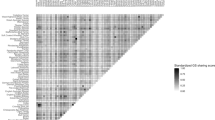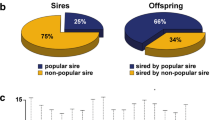Abstract
Naturally occurring diseases in dogs provide an important animal model for studying human disease including cancer, heart disease, and autoimmune disorders. Transposable elements (TEs) make up ~ 31% of the dog (Canis lupus familiaris) genome and are one of main drivers to cause genomic variations and alter gene expression patterns of the host genes, which could result in genetic diseases. To detect structural variations (SVs), we conducted whole-genome sequencing of three different breeds, including Maltese, Poodle, and Yorkshire Terrier. Genomic SVs were detected and visualized using BreakDancer program. We identified a total of 2328 deletion SV events in the three breeds compared with the dog reference genome of Boxer. The majority of the genetic variants were found to be TE insertion polymorphism (1229) and the others were TE-mediated deletion (489), non-TE-mediated deletion (542), simple repeat-mediated deletion (32), and other indel (36). Among the TE insertion polymorphism, 286 elements were full-length LINE-1s (L1s). In addition, the 49 SV candidates located in the genic regions were experimentally verified and their polymorphic rates within each breed were examined using PCR assay. Polymorphism analysis of the genomic variants revealed that some of the variants exist polymorphic in the three dog breeds, suggesting that their SV events recently occurred in the dog genome. The findings suggest that TEs have contributed to the genomic variations among the three dog breeds of Maltese, Poodle, and Yorkshire Terrier. In addition, the polymorphic events between the dog breeds indicate that TEs were recently retrotransposed in the dog genome.






Similar content being viewed by others
Data availability
The whole-genome sequencing data have been deposited into NCBI Short Read Archive (SRA) under the project SRP159058.
References
Ayarpadikannan S, Kim HS (2014) The impact of transposable elements in genome evolution and genetic instability and their implications in various diseases. Genomics Inform 12:98–104
Barrio AM, Ekerljung M, Jern P, Benachenhou F, Sperber GO, Bongcam-Rudloff E, Blomberg J, Andersson G (2011) The first sequenced carnivore genome shows complex host-endogenous retrovirus relationships. PLoS ONE 6:e19832
Beck CR, Garcia-Perez JL, Badge RM, Moran JV (2011) LINE-1 elements in structural variation and disease. Annu Rev Genomics Hum Genet 12:187–215
Bergman CM, Quesneville H (2007) Discovering and detecting transposable elements in genome sequences. Brief Bioinform 8:382–392
Britten RJ (2010) Transposable element insertions have strongly affected human evolution. Proc Natl Acad Sci USA 107:19945–19948
Chen K, Wallis JW, McLellan MD, Larson DE, Kalicki JM, Pohl CS, McGrath SD, Wendl MC, Zhang Q, Locke DP et al (2009) BreakDancer: an algorithm for high-resolution mapping of genomic structural variation. Nat Methods 6:677–681
Conrad DF, Pinto D, Redon R, Feuk L, Gokcumen O, Zhang Y, Aerts J, Andrews TD, Barnes C, Campbell P et al (2010) Origins and functional impact of copy number variation in the human genome. Nature 464:704–712
Cordaux R, Batzer MA (2009) The impact of retrotransposons on human genome evolution. Nat Rev Genet 10:691–703
Cost GJ, Feng Q, Jacquier A, Boeke JD (2002) Human L1 element target-primed reverse transcription in vitro. EMBO J 21:5899–5910
Cozar M, Bembi B, Dominissini S, Zampieri S, Vilageliu L, Grinberg D, Dardis A (2011) Molecular characterization of a new deletion of the GBA1 gene due to an inter Alu recombination event. Mol Genet Metab 102:226–228
Crooks GE, Hon G, Chandonia JM, Brenner SE (2004) WebLogo: a sequence logo generator. Genome Res 14:1188–1190
Davis AJ, Chen DJ (2013) DNA double strand break repair via non-homologous end-joining. Transl Cancer Res 2:130–143
Deininger PL, Moran JV, Batzer MA, Kazazian HH Jr (2003) Mobile elements and mammalian genome evolution. Curr Opin Genet Dev 13:651–658
Dewannieux M, Esnault C, Heidmann T (2003) LINE-mediated retrotransposition of marked Alu sequences. Nat Genet 35:41–48
Ewing AD (2015) Transposable element detection from whole genome sequence data. Mob DNA 6:24
Fan X, Abbott TE, Larson D, Chen K (2014) BreakDancer: identification of genomic structural variation from paired-end read mapping. Curr Protoc Bioinform 45:15
Feng Q, Moran JV, Kazazian HH Jr, Boeke JD (1996) Human L1 retrotransposon encodes a conserved endonuclease required for retrotransposition. Cell 87:905–916
Freedman AH, Gronau I, Schweizer RM, Ortega-Del Vecchyo D, Han E, Silva PM, Galaverni M, Fan Z, Marx P, Lorente-Galdos B et al (2014) Genome sequencing highlights the dynamic early history of dogs. PLoS Genet 10:e1004016
Goncalves A, Oliveira J, Coelho T, Taipa R, Melo-Pires M, Sousa M, Santos R (2017) Exonization of an intronic LINE-1 element causing Becker muscular dystrophy as a novel mutational mechanism in dystrophin gene. Genes (Basel) 8(10):253
Goodier JL, Ostertag EM, Kazazian HH Jr (2000) Transduction of 3′-flanking sequences is common in L1 retrotransposition. Hum Mol Genet 9:653–657
Gu W, Zhang F, Lupski JR (2008) Mechanisms for human genomic rearrangements. Pathogenetics 1:4
Hall TA (1999) BioEdit: a user-friendly biological sequence alignment editor and analysis program for Windows 95/98/NT. Nucleic Acids Symp Ser (Oxf) 41:95–98
Han K, Sen SK, Wang J, Callinan PA, Lee J, Cordaux R, Liang P, Batzer MA (2005) Genomic rearrangements by LINE-1 insertion-mediated deletion in the human and chimpanzee lineages. Nucleic Acids Res 33:4040–4052
Huang XQ, Zhou ZQ, Zhang XF, Chen CL, Tang Y, Zhu Q, Zhang JH, Xia JC (2017) Overexpression of SMOC2 attenuates the tumorigenicity of hepatocellular carcinoma cells and is associated with a positive postoperative prognosis in human hepatocellular carcinoma. J Cancer 8:3812–3827
Hulsen T, de Vlieg J, Alkema W (2008) BioVenn–a web application for the comparison and visualization of biological lists using area-proportional Venn diagrams. BMC Genomics 9:488
Irion DN, Schaffer AL, Famula TR, Eggleston ML, Hughes SS, Pedersen NC (2003) Analysis of genetic variation in 28 dog breed populations with 100 microsatellite markers. J Hered 94:81–87
Ishmukhametova A, Chen JM, Bernard R, de Massy B, Baudat F, Boyer A, Mechin D, Thorel D, Chabrol B, Vincent MC et al (2013) Dissecting the structure and mechanism of a complex duplication-triplication rearrangement in the DMD gene. Hum Mutat 34:1080–1084
Jones DT, Taylor WR, Thornton JM (1992) The rapid generation of mutation data matrices from protein sequences. Comput Appl Biosci 8:275–282
Kazazian HH Jr (2014) Processed pseudogene insertions in somatic cells. Mob DNA 5:20
Kazazian HH Jr, Moran JV (1998) The impact of L1 retrotransposons on the human genome. Nat Genet 19:19–24
Kim S, Cho CS, Han K, Lee J (2016) Structural variation of Alu element and human disease. Genom Inform 14:70–77
Kirkness EF, Bafna V, Halpern AL, Levy S, Remington K, Rusch DB, Delcher AL, Pop M, Wang W, Fraser CM et al (2003) The dog genome: survey sequencing and comparative analysis. Science 301:1898–1903
Kumar S, Stecher G, Tamura K (2016) MEGA7: molecular evolutionary genetics analysis version 7.0 for bigger datasets. Mol Biol Evol 33:1870–1874
Lander ES, Linton LM, Birren B, Nusbaum C, Zody MC, Baldwin J, Devon K, Dewar K, Doyle M, FitzHugh W et al (2001) Initial sequencing and analysis of the human genome. Nature 409:860–921
Lee HE, Ayarpadikannan S, Kim HS (2015) Role of transposable elements in genomic rearrangement, evolution, gene regulation and epigenetics in primates. Genes Genet Syst 90:245–257
Li H, Durbin R (2009) Fast and accurate short read alignment with Burrows-Wheeler transform. Bioinformatics 25:1754–1760
Lindblad-Toh K, Wade CM, Mikkelsen TS, Karlsson EK, Jaffe DB, Kamal M, Clamp M, Chang JL, Kulbokas EJ 3rd, Zody MC et al (2005) Genome sequence, comparative analysis and haplotype structure of the domestic dog. Nature 438:803–819
Marchant TW, Johnson EJ, McTeir L, Johnson CI, Gow A, Liuti T, Kuehn D, Svenson K, Bermingham ML, Drogemuller M et al (2017) Canine brachycephaly is associated with a retrotransposon-mediated missplicing of SMOC2. Curr Biol 27(1573–1584):e1576
Martin SL (2006) The ORF1 protein encoded by LINE-1: structure and function during L1 retrotransposition. J Biomed Biotechnol 2006:45621
Mills RE, Walter K, Stewart C, Handsaker RE, Chen K, Alkan C, Abyzov A, Yoon SC, Ye K, Cheetham RK et al (2011) Mapping copy number variation by population-scale genome sequencing. Nature 470:59–65
Nozu K, Iijima K, Ohtsuka Y, Fu XJ, Kaito H, Nakanishi K, Vorechovsky I (2014) Alport syndrome caused by a COL4A5 deletion and exonization of an adjacent AluY. Mol Genet Genomic Med 2:451–453
O’Donnell KA, Burns KH (2010) Mobilizing diversity: transposable element insertions in genetic variation and disease. Mob DNA 1:21
Ostrander EA, Wayne RK (2005) The canine genome. Genome Res 15:1706–1716
Parker HG, Kim LV, Sutter NB, Carlson S, Lorentzen TD, Malek TB, Johnson GS, DeFrance HB, Ostrander EA, Kruglyak L (2004) Genetic structure of the purebred domestic dog. Science 304:1160–1164
Peeters T, Monteagudo S, Tylzanowski P, Luyten FP, Lories R, Cailotto F (2018) SMOC2 inhibits calcification of osteoprogenitor and endothelial cells. PLoS ONE 13:e0198104
Pickeral OK, Makalowski W, Boguski MS, Boeke JD (2000) Frequent human genomic DNA transduction driven by LINE-1 retrotransposition. Genome Res 10:411–415
Quinlan AR, Hall IM (2010) BEDTools: a flexible suite of utilities for comparing genomic features. Bioinformatics 26:841–842
Richardson SR, Doucet AJ, Kopera HC, Moldovan JB, Garcia-Perez JL, Moran JV (2015) The influence of LINE-1 and SINE retrotransposons on mammalian genomes. Microbiol Spectr 3:3
Robberecht C, Voet T, Zamani Esteki M, Nowakowska BA, Vermeesch JR (2013) Nonallelic homologous recombination between retrotransposable elements is a driver of de novo unbalanced translocations. Genome Res 23:411–418
Segal Y, Peissel B, Renieri A, de Marchi M, Ballabio A, Pei Y, Zhou J (1999) LINE-1 elements at the sites of molecular rearrangements in Alport syndrome-diffuse leiomyomatosis. Am J Hum Genet 64:62–69
Shearin AL, Ostrander EA (2010) Leading the way: canine models of genomics and disease. Dis Model Mech 3:27–34
Swergold GD (1990) Identification, characterization, and cell specificity of a human LINE-1 promoter. Mol Cell Biol 10:6718–6729
Szak ST, Pickeral OK, Landsman D, Boeke JD (2003) Identifying related L1 retrotransposons by analyzing 3′ transduced sequences. Genome Biol 4:R30
Temtamy SA, Aglan MS, Valencia M, Cocchi G, Pacheco M, Ashour AM, Amr KS, Helmy SM, El-Gammal MA, Wright M et al (2008) Long interspersed nuclear element-1 (LINE1)-mediated deletion of EVC, EVC2, C4orf6, and STK32B in Ellis-van Creveld syndrome with borderline intelligence. Hum Mutat 29:931–938
VanBelzen DJ, Malik AS, Henthorn PS, Kornegay JN, Stedman HH (2017) Mechanism of deletion removing all dystrophin exons in a canine model for DMD implicates concerted evolution of X chromosome pseudogenes. Mol Ther Methods Clin Dev 4:62–71
Wang W, Kirkness EF (2005) Short interspersed elements (SINEs) are a major source of canine genomic diversity. Genome Res 15:1798–1808
Wayne RK (1993) Molecular evolution of the dog family. Trends Genet 9:218–224
Xing J, Wang H, Belancio VP, Cordaux R, Deininger PL, Batzer MA (2006) Emergence of primate genes by retrotransposon-mediated sequence transduction. Proc Natl Acad Sci USA 103:17608–17613
Acknowledgements
This research was supported by the Bio & Medical Technology Development Program of the National Research Foundation (NRF) funded by the Ministry of Science & ICT (NRF-2016M3A9B6026771) and (NRF-2016M3A9B6026776).
Author information
Authors and Affiliations
Corresponding authors
Ethics declarations
Conflict of interest
The authors declare that there is no conflict of interest regarding the publication of this paper.
Ethical approval
This study was reviewed and approved by the Seoul National University Institutional Animal Care and Use Committee (IACUC# SNU-170602-1).
Additional information
Publisher's Note
Springer Nature remains neutral with regard to jurisdictional claims in published maps and institutional affiliations.
Electronic supplementary material
Below is the link to the electronic supplementary material.
335_2019_9812_MOESM2_ESM.xlsx
Supplementary material 2 (XLSX 2607 kb). Raw data of five structural variations in three dog predicted from three dog breeds genome using BreakDancer
335_2019_9812_MOESM6_ESM.pdf
Supplementary material 6 (PDF 58 kb). Molecular phylogenetic analysis of 10 mammals based on amino acids of 36 orthologs
Rights and permissions
About this article
Cite this article
Kim, S., Mun, S., Kim, T. et al. Transposable element-mediated structural variation analysis in dog breeds using whole-genome sequencing. Mamm Genome 30, 289–300 (2019). https://doi.org/10.1007/s00335-019-09812-5
Received:
Accepted:
Published:
Issue Date:
DOI: https://doi.org/10.1007/s00335-019-09812-5




